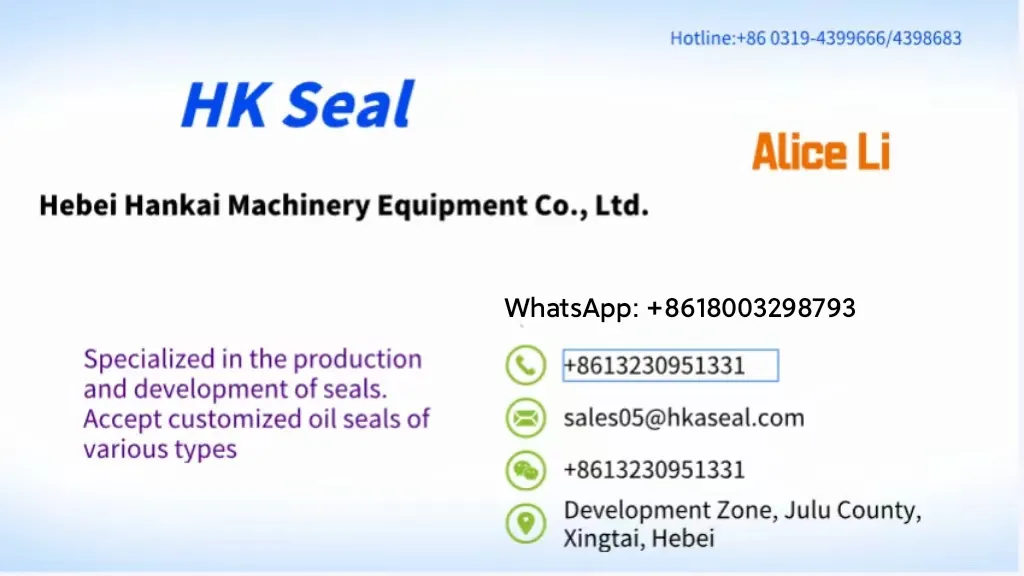Nov . 28, 2024 01:05 Back to list
Hydraulic Cylinder Seal Kit Materials and Their Applications in Fluid Power Systems
Understanding Hydraulic Cylinder Seal Kit Materials
Hydraulic systems are integral to various industries, playing a crucial role in machinery operation, automation, and even mobile applications. The efficiency and reliability of these systems heavily depend on the hydraulic cylinder seal kits, which are designed to prevent fluid leakage, protect internal components, and ensure optimal performance. A significant aspect of these seal kits is the material used in their composition, as this directly influences their durability, compatibility, and overall effectiveness.
Common Materials Used in Hydraulic Cylinder Seal Kits
Hydraulic seals are made from a variety of materials, each offering unique properties that make them suitable for different applications. Here are some of the most common materials used in hydraulic cylinder seal kits
1. Nitrile Rubber (NBR) This is the most widely used material for hydraulic seals due to its excellent oil resistance and good mechanical properties. NBR is relatively inexpensive and can operate within a temperature range of -40°C to 100°C. However, it does not perform well with high temperatures or aggressive fluids, making it less suitable for certain environments.
2. Fluoroelastomer (FKM) Fluoroelastomers, commonly known by the brand name Viton, are highly resistant to high temperatures and aggressive chemicals. They can withstand temperatures of up to 200°C. Their superior chemical resistance makes them suitable for harsh environments, including those involving petroleum-based fluids, high-pressure applications, and high-temperature conditions.
3. Polyurethane (PUR) Polyurethane seals are known for their exceptional wear resistance and high elasticity. They can tolerate a broad temperature range and are particularly effective in dynamic sealing applications. Additionally, polyurethane exhibits excellent abrasion resistance, making it a popular choice in heavy-duty applications, such as hydraulic cylinders in construction equipment and agricultural machinery.
4. PTFE (Polytetrafluoroethylene) PTFE seals are renowned for their low friction and exceptional chemical resistance. They can operate in extreme temperatures (from -200°C to 260°C) and are ideal for applications where chemical compatibility is essential. PTFE is often used in conjunction with other seal materials to enhance performance in critical sealing applications.
hydraulic cylinder seal kit material

5. Acetal (POM) Although less common, acetal seals are used in applications where low friction and dimensional stability are crucial. They excel in applications with moderate temperatures and pressures and are often applied in hydraulic applications that require a combination of strength and low wear.
Choosing the Right Material
Selecting the right material for hydraulic cylinder seal kits depends on several factors, including the environmental conditions, the type of fluid being used, temperature fluctuations, and the system's pressure levels. It is critical to understand the specific requirements of your application in order to choose the right seal material.
- Temperature Tolerance Knowing the operating temperature range is vital to avoiding seal breakdown. High temperatures may require materials like FKM or PTFE, while lower-temperature applications may function well with NBR.
- Fluid Compatibility Different materials react differently to various fluids. Always consult compatibility charts to ensure the chosen seal material is suitable for the hydraulic fluid being used, as this can prevent premature seal failure.
- Mechanical Properties Consider the dynamic and static sealing requirements your application demands. Material selection should account for pressures, movement types (linear or rotary), and potential abrasion from particles within the hydraulic fluid.
Conclusion
The material used in hydraulic cylinder seal kits is a critical factor that determines the efficiency, reliability, and longevity of hydraulic systems. Understanding the characteristics of common materials like NBR, FKM, polyurethane, PTFE, and acetal helps in making informed choices that enhance performance and reduce maintenance costs. As industries continue to evolve, so too will the development of innovative seal materials capable of meeting the challenges posed by high-performance hydraulic systems. Adopting the right sealing technology is essential for optimal hydraulic performance, promoting longevity and sustainability in machinery operations.
-
TCN Oil Seal Metal Ring Reinforcement for Heavy Machinery
NewsJul.25,2025
-
Rotary Lip Seal Spring-Loaded Design for High-Speed Applications
NewsJul.25,2025
-
Hydraulic Cylinder Seals Polyurethane Material for High-Impact Jobs
NewsJul.25,2025
-
High Pressure Oil Seal Polyurethane Coating Wear Resistance
NewsJul.25,2025
-
Dust Proof Seal Double Lip Design for Construction Equipment
NewsJul.25,2025
-
Hub Seal Polyurethane Wear Resistance in Agricultural Vehicles
NewsJul.25,2025
-
The Trans-formative Journey of Wheel Hub Oil Seals
NewsJun.06,2025
Products categories
















